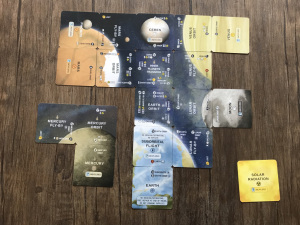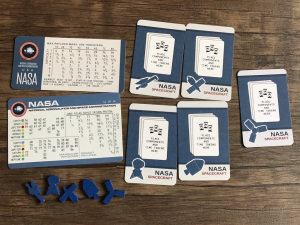| Game Name: | Leaving Earth | Published Year: | 2015 |
| Game Publisher: | The Lumenaris Group, Inc. | Player Scale: | 1-5 |
| Game Designer: | Joseph Fatula | Run Time: | 60-180 min |
Welcome to Leaving Earth, a game about the space race. In this review, I will cover both the base game and the expansion Leaving Earth: Outer Planets. In Leaving Earth, you’ll take control of one of the world’s space agencies and will try to accomplish missions in space. If you want to be the first and grab the glory, you’ll need to plan and assess the risk of doing the mission before other players grab the points.

Full game setup (using only 1 of the 5 agencies) with the Outer Planets expansion.
How it plays

Base game map.
You are presented with a map of the solar system detailing different zones and how they’re interconnected. The base game is only composed of Planet Earth, the Moon, Venus and Mars. If you get the second edition of the game it will come with a mini expansion integrating Mercury.
The Outer planet expansion will add Jupiter, Saturn, Uranus, Neptune and a number of their satellites for you to explore. The locations that can be explored have multiple copies so the exploration results will be randomized in every game, as you only use on of them per game.

Multiple copies of an exploration place with different results in the reverse.
The game will play in a limited number of rounds representing each a year, starting at 1956 and going all the way up to 1976 on the base game or 1986 with the Outer Planet expansion. Every year all the agencies get the same amount of funding and they need to spend it on developing technologies, building spacecrafts, training astronauts, … In your turn you can also build spacecrafts with the pieces you already have and launch missions into space.
Each round, all players get a turn and they can perform as many actions as they can or are able and then the next player goes. If you don’t spend your funding it is lost, and in the next year you’ll start with the same amount as every year. Once everybody has done their actions you resolve all the end of year actions like feeding your astronauts in space or resolving any perils.

Technologies and manoeuvers.
There is a large selection of technologies you can develop, and these will be prerequisites for most of the rockets you can build or certain manoeuvres you can perform in your missions later on. When you develop a technology, you always get a certain amount of outcome cards that go along with it. Every time you fire a rocket or perform a manoeuvre involving one of the technologies you have to flip one of those cards.

You can have 3 different results, a success, so everything goes as planned. A minor fail, which usually result in something not working but able to be repaired. A major fail, which usually result in everything getting lost in a big ball of fire. Independently of the result, you can get rid of the card once revealed by paying the amount indicated, if not it will get shuffled back with the other cards. This mechanic will include a bit of luck and uncertainty to every action you do in your missions. You can perform tests as many times as you want, paying to get rid of the cards, once you have no more cards is always an automatic success, however; this requires money and time that you might not have, remember, this is a race after all.

Mission cards
Missions will be assigned in the game’s set up, depending on the chosen difficulty for the game you will draw a certain number of cards from the easy, medium and hard missions decks. Including the Outer Planets expansion this changes a bit, apart from the missions you draw from these decks, there will be a certain number of non-explorable missions from the outer planets, and while exploring the locations it will add extra missions. As you don’t use all missions in a game this will add to the replayability of the game. All missions are available for everybody and they are worth a number of points. The first person to accomplish a mission gets the corresponding card with its points. When this happens, all other agencies receive a bonus in their funding for the year. There is a wide range of missions, from a simple survey, to find life or bring samples back to Earth.

Example from the rulebook of planning a mission.
Planning a mission is an essential part of the game, and unfortunately, might involve too much math for some people. Based on the difficulty of the manoeuvres and the mass you’re trying to move you’ll need to calculate the amount of thrust you’ll need for the different manoeuvres. Fortunately for you, if using basic mathematical formulae and calculator seems out of place for a game, each agency card has a table saying how many rockets of each type you’ll need to use depending on the difficulty of the manoeuvre and the mass you want to move. You’ll still need to plan using pen and paper for the hardest missions.

The Outer Planets calendar track shows the windows of opportunity for the slingshot manoeuvres.
With the Outer Planets expansion the slingshot manoeuvres were incorporated, as these depend on the alignment of the planets, you’ll need to look for windows of opportunity based on the calendar year planning your missions, adding, even more, depth to the game system.
Solo Game

Components for one of the agencies.
The solo game is a bit different, you still run the space program for an agency, but as you are not competing with anyone you can perfectly plan your movements. There is a win condition though, you need to have more than half of the points of the total missions by the end of the game. To keep the game challenging is recommended to play in difficulty high or very high. With the addition of the Outer Planets expansions, some of the missions are unknown until you explore the planets or satellites, which will add further difficulty. The agreed convention on how to play this is you need to accomplish all the non-explorable missions of the outer planets and then with all available, you have to score half of the points. This is one of my favourite games in my collection to play solo, I highly recommend it if you like the theme and don’t mind doing some basic math.
Opinion

The 5 space agencies of the game
The game is all about planning, there is a bit of luck involved with the outcome cards as you can get delays due to fails, but the game is very strategic. The different agencies add to the theme, but they are all the same, so there is no asymmetry in the game. There are different approaches to each mission, there will be an optimal solution, but it will take you a few games to gain enough experience with all the technologies and there is the race aspect of the game, your mission might be the optimal one, but if someone tries their luck and achieves the mission before you all that planning might be for nothing. This is where you need to assess if taking the risk is worth it.
There is definitely a learning curve in the game, but with the different difficulty levels, you can approach the harder missions at your own pace while exploring the game. The fact that the exploration places are random and that there are so many missions in the pool is going to be rare to play the same game twice in a row, the replayability is very high. The fact that the game is so mathy might put some people off, but for me is one of the reasons I like this game so much. In big groups, the downtime might be too long if a couple of players suffer from analysis paralysis frequently, and for me, this is a brilliant game as solitaire.
The artwork is just magnificent, it’s got this retro vibe of the space race and the map looks gorgeous displayed on the table. The components are good quality but being a game produced by demand you can see that is not from a big production company. One of the problems of this is that is not widely available though now is easily ordered in different online shops in EU. As a fan fact, if you happen to visit NASA you can actually grab a copy there. The rulebook is very well displayed and I didn’t find it difficult to get into the game, and Joseph is always willing to answer anyone in BGG forums if you have any questions regarding the game.
The good: Highly thematic, gorgeous artwork, brilliant gameplay. Multiplayer is quite tense and solo is a great puzzle.
The bad: If you play in a big group the down-time between turns might be quite big if the players like to take their time planning. Some people might not like the mathy aspect of the game.
You might also like: High Frontier (3rd Edition)
That’s all for the review folks!
If the idea of cruising into space making the next great discoveries of humankind appeals to you, this is a piece of art to have in your collection. Try to replicate the Voyager program or the Cassini mission which will end in September ‘17 with the spacecraft crashing into Saturn. I leave you now with one of the latest photographs of this great mission (thanks to the NASA image gallery)






